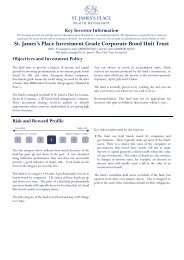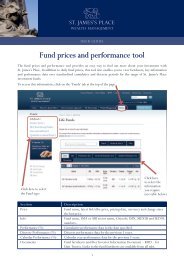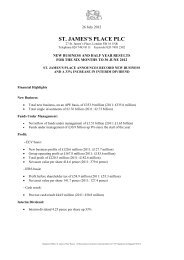Summer Investor Magazine - St James's Place
Summer Investor Magazine - St James's Place
Summer Investor Magazine - St James's Place
You also want an ePaper? Increase the reach of your titles
YUMPU automatically turns print PDFs into web optimized ePapers that Google loves.
ISSUE 70 | SUmmEr 2011<br />
Cook’s endeavour<br />
england CriCket<br />
sensation explores<br />
his suCCess
THE INVESTOR<br />
welcome<br />
contents<br />
W<br />
elcome to the latest edition of<br />
The <strong>Investor</strong>.<br />
The best word to sum up the current<br />
economic climate is uncertain. Will inflation<br />
moderate or continue to rise Will Europe<br />
manage to overcome its financial crisis How much longer can UK<br />
interest rates remain at these record low levels In this issue we<br />
look at the impact of these uncertainties on the global economy and<br />
consider how, and when, they might be resolved.<br />
For the England cricket team, by contrast, the key word for<br />
the moment is success. We have an interview with one of the key<br />
architects of that success, batsman Alastair Cook.<br />
Technology has already transformed our business and personal<br />
lives, but the pace of change continues to quicken. Innovations such<br />
as smartphones, social networking sites and now cloud computing<br />
bring with them more, as yet unknown, changes to come. We<br />
report on how technology is helping some new companies steal<br />
a march on their more established rivals.<br />
This is my last welcome letter as I am stepping down as<br />
Chairman of the Investment Committee and will be handing over<br />
to Vivian Bazalgette, who has been a member of the Investment<br />
Committee since 2010. I have thoroughly enjoyed my time as<br />
Chairman and leave the position in good hands.<br />
I do hope there will be lots in this edition to interest you.<br />
If you have any queries, please do not hesitate to contact your<br />
<strong>St</strong>. James’s <strong>Place</strong> Partner.<br />
Sir Mark Weinberg<br />
Chairman, Investment Committee,<br />
<strong>St</strong>. James’s <strong>Place</strong> Wealth Management<br />
FOR FURTHER INFORMATION ON ANY OF THE ARTICLES IN THIS ISSUE OF THE INVESTOR, PLEASE CONTACT YOUR ST. JAMES’S PLACE PARTNER<br />
All facts and statistics in this issue of The <strong>Investor</strong> are correct at the time of going to press. Cover image: Pål Hansen<br />
08<br />
10<br />
Northern European<br />
powerhouses still in<br />
robust health<br />
Analysis, page 6<br />
ANALYSIS<br />
04 News<br />
The great interest rate debate<br />
and what next year’s compulsory<br />
new pension scheme will mean<br />
for employers<br />
06 A tale of two Europes<br />
Investigating the economic north/<br />
south divide splitting the continent<br />
14 Technology comes of age<br />
With tech companies once again<br />
in high demand, Heather Connon<br />
analyses the latest innovations<br />
INTERVIEWS<br />
08 Man of the century<br />
England cricket sensation Alastair<br />
Cook talks about his success so far<br />
16 A day in the life<br />
Kevin Murphy, Schroders’ UK Equity<br />
Manager, describes his daily routine<br />
IN YOUR INTEREST<br />
10 Finding some shelter<br />
How best to protect your<br />
investments amid high infl ation<br />
12 Balancing the books<br />
The real impact of funding university<br />
and why it pays to prepare early<br />
13 What’s your exit strategy<br />
Why entrepreneurs should plan ahead<br />
for the day they sell their business<br />
FUND ANALYSIS<br />
17 Fund manager analysis<br />
Your guide to <strong>St</strong>. James’s <strong>Place</strong> funds<br />
DATA<br />
26 Fund and market data<br />
Latest information from funds and<br />
fi nancial markets, including graphs,<br />
statistics and market data<br />
A Day in the Life, page 16<br />
02 | THE INVESTOR<br />
THE INVESTOR | 03
analysis<br />
analysis<br />
news<br />
pensions<br />
building a nEsT Egg<br />
What will next year’s compulsory new pension scheme<br />
mean for employers<br />
economic outlook<br />
THE gREaT inTEREsT RaTE dEbaTE<br />
They have been at record lows for more than two years.<br />
What prospect is there of rate rises<br />
Since 1970, interest rates have been less than 4% for just<br />
44 months – the bulk of that in this current prolonged period<br />
of record low rates – and the average has been above 9.2%.<br />
Small wonder, then, that the most popular game among<br />
economists is guessing when, and how quickly, rates will rise<br />
from the level of 0.5% plumbed in November 2008. As soon<br />
as one piece of economic data seems to pave the way for<br />
a rise – stubbornly high inflation, for example – another<br />
statistic emerges to underline the need to keep interest<br />
rates lower for longer, such as flagging economic growth.<br />
The Organisation for Economic Co-operation and<br />
Development supported an increase when it warned that<br />
rates would have to rise this year to stave off inflationary<br />
pressures. Meanwhile, the respected Ernst & Young<br />
Independent Treasury Economic Model (ITEM) Club made<br />
a plea to keep rates low until at least November to avoid<br />
undermining fragile consumer confidence.<br />
It is a difficult balancing act. While a rise in interest rates<br />
would be good for savers, it could hit borrowers hard. An<br />
analysis by insurance group Legal & General suggests that<br />
as many as 90% of mortgages are now on variable rates,<br />
compared with 60% in 2007. Borrowers’ spending power<br />
could be significantly affected by a rise in interest rates –<br />
and remember, even a 0.5% rise is a doubling of base rates<br />
from current levels.<br />
The Bank of England is hoping that we consumers will<br />
keep spending enough to keep the economy on a recovery<br />
track. With tax increases now starting to bite, inflation rising<br />
sharply, as explained in our feature on page 10, and the<br />
public sector still shedding jobs, there are plenty of reasons<br />
for the Bank’s Monetary Policy Committee to worry about<br />
doing anything to rock consumer confidence.<br />
The statistics for the manufacturing industry, also a key<br />
part of the government’s recovery hopes, have also become<br />
less positive lately. Indeed, some analysts have suggested<br />
that this has been the slowest economic recovery of any<br />
recession in the past 180 years. The summer is generally a<br />
much quieter time on the economic front anyway, so it could<br />
be at least the autumn before there is any more clarity about<br />
the interest rate outlook.<br />
The European Central Bank has already taken the plunge<br />
but, as outlined in our feature on page 6, northern Europe is<br />
already enjoying a good recovery. Meanwhile, Britain still has<br />
some way to go before it can say the same.<br />
Getty Images, The Guardian<br />
You may be aware that a<br />
new pension scheme is being<br />
introduced by the government:<br />
NEST, or the National<br />
Employment Savings Trust. What<br />
you may be less aware of is how<br />
far-reaching the scheme will be.<br />
<strong>St</strong>arting in 2012, every<br />
employee aged over 22 and<br />
earning more than the threshold<br />
for paying basic rate tax –<br />
currently £7,475 – must be<br />
offered the opportunity to join<br />
a workplace pension scheme.<br />
That means NEST will not just<br />
cover those working in factories,<br />
shops and offices, but also<br />
domestic staff, such as cleaners<br />
and gardeners.<br />
The introduction is phased<br />
over five years, with larger<br />
employers going first, but<br />
everyone who employs staff<br />
should be starting to assess the<br />
implications of NEST.<br />
The reason for introducing<br />
NEST is straightforward: funding<br />
retirement is becoming very<br />
expensive. By 2030, a third<br />
of the population will be above<br />
the state retirement age¹ and<br />
a woman reaching 65 in that<br />
year can be expected to live for<br />
another 25.9 years, and a man<br />
23.4 years.²<br />
Yet only around 40% of us<br />
is making any pension savings<br />
outside the state scheme³. NEST<br />
is designed to plug that gap.<br />
The minimum contribution<br />
will increase in stages until<br />
2017, when it will be 8% of<br />
employee’s salary between<br />
£5,715 and £38,135, made<br />
up of 3% from the employers,<br />
4% from the employee and 1%<br />
tax rebate.<br />
Employees do not have to join<br />
the scheme, but their bosses<br />
need to ask them to join again<br />
every three years.<br />
For employees, NEST is<br />
designed to be simple and<br />
transparent. They will be able<br />
to take their pot with them<br />
whenever they change jobs<br />
and they will be able to keep<br />
track of their pension pot by<br />
logging on to their personal<br />
online account.<br />
The maximum annual<br />
contribution will be £3,600,<br />
which will not provide a<br />
particularly generous pension,<br />
although this limit may be<br />
abolished from 2017.<br />
Employers can also choose<br />
to use their own scheme<br />
rather than signing up to NEST,<br />
provided it meets the criteria<br />
for approval. NEST says signing<br />
up will be easy and will be done<br />
online, but final details have still<br />
to be released.<br />
Anyone who is concerned<br />
about the implications of<br />
the scheme should seek<br />
professional advice.<br />
sources<br />
¹ www.pensionspolicyinstitute.<br />
org.uk/default.aspp=68<br />
² www.pensionspolicyinstitute.<br />
org.uk/default.aspp=69<br />
³ www.pensionspolicyinstitute.<br />
org.uk/default.aspp=81<br />
04 | THE inVEsTOR<br />
THE inVEsTOR | 05
ANALYSIS<br />
ANALYSIS<br />
SPECIAL REPORT<br />
Illustration: Craig Robertson@Debut Art. Photo: i<strong>St</strong>ockphoto<br />
PORTUGAL’S DEBT<br />
93% of GDP<br />
IRELAND’S DEBT<br />
96.2% of GDP<br />
SPAIN’S DEBT<br />
60.1% of GDP<br />
GREECE’S DEBT<br />
142.8% of GDP<br />
a tale of<br />
two europes<br />
The continent’s northern countries remain in rude health despite<br />
the economic crisis engulfi ng the south<br />
Government debt as a percentage of GDP as at 2010. Source: European Commission<br />
There is an economic<br />
divide running through<br />
the middle of Europe<br />
and it is getting wider.<br />
Southern Europe<br />
is struggling with crippling debts and<br />
stagnant economic growth while the<br />
north is in robust fi nancial health.<br />
Expressed at its simplest, the PIGS<br />
– the pejorative acronym for Portugal,<br />
Ireland, Greece and Spain – borrowed too<br />
much when credit was easy and in today’s<br />
harsh post-credit crunch reality, they are<br />
struggling to cut their debts and their<br />
spending while keeping their citizens onside.<br />
The northern countries of Europe –<br />
Germany, France and Scandinavia – on the<br />
other hand, were far more measured in<br />
their appetite for credit during good times,<br />
and so are suffering less in the lean years.<br />
They are also home to some of the best<br />
manufacturing companies Europe has to<br />
offer, companies that are continuing to find<br />
markets for their products in faster-growing<br />
emerging and Asian markets. ‘In October<br />
2009, the IMF predicted that the German<br />
economy would grow by just 0.3% last year.<br />
In reality, it grew by 3.3%,’ says Alexander<br />
Darwall, head of European equities at fund<br />
management group Jupiter.<br />
The high level of sovereign debt among<br />
the southern countries, in particular, is<br />
still worrying financial analysts. Indeed,<br />
many question whether countries like<br />
Greece can ever pay their debts – and some<br />
doubt whether they can remain within<br />
the euro. Ruth Lea, economic adviser to<br />
the Arbuthnot Banking Group, says: ‘The<br />
bailouts for Greece, Ireland and Portugal<br />
are most unlikely to solve the economic<br />
problems of any of these countries. Apart<br />
from the unsustainably high debt levels, their<br />
economies lack the competitiveness to grow<br />
and prosper. At some point, the EU will have<br />
to consider much more radical solutions.’<br />
But it is important to differentiate<br />
between the fiscal crisis engulfing much<br />
of southern Europe from the outlook<br />
for European companies. ‘The sovereign<br />
debt crisis and economic backdrop – with<br />
Europe’s share of world trade falling – is<br />
not good, but you have to divorce the<br />
corporate sector, which people invest in, and<br />
the government finance issues in southern<br />
Europe,’ says Darwall. ‘If Greece, Portugal<br />
or Ireland defaults it will present difficulties,<br />
but their share of European trade is small.’<br />
Darwall emphasises not just the fiscal<br />
prudence of much of northern Europe, but<br />
the export strength of its corporate sector.<br />
‘Should you be excited by listed European<br />
companies You bet – big companies from<br />
Germany are the best in the world at<br />
what they do. These companies don’t care<br />
about the PIGS; they have far bigger and<br />
more important markets out there to take<br />
advantage of,’ he says.<br />
China is far more important to Europe’s<br />
outlook than the PIGS. Fewer than one in<br />
20 Chinese people has a car, but prestige<br />
brands like Germany’s BMW are in a strong<br />
position. Darwall also uses the example of<br />
the Swiss watch industry, which has seen a<br />
33% uplift in sales in the past year: ‘This just<br />
shows the effects the expansion of the Asian<br />
economies is having on traditional exclusive<br />
brand industries in Europe.’<br />
A default on their debt by one of the<br />
PIGS – which is a real possibility – or the<br />
departure of one of the countries from<br />
the euro would undoubtedly be seen as a<br />
setback that could upset investors, but the<br />
underlying strength of the north means that<br />
should be short-lived.<br />
In conclusion, Darwall says: ‘A lot<br />
of UK investors have been quite sniffy<br />
about Europe in the past, lumping [all the<br />
countries] together, but fund managers<br />
will probably own very little stock in the<br />
countries worst affected by the crisis.<br />
‘When you look at many of the northern<br />
European countries, their finances are in<br />
a sound condition, as they have made the<br />
right economic decisions over the past few<br />
years and this is paying off.’<br />
■ JULIAN KNIGHT IS MONEY EDITOR OF<br />
THE INDEPENDENT ON SUNDAY<br />
FUTURE OF<br />
THE EURO<br />
Can the euro survive in its current form<br />
If some of the PIGS are forced out of<br />
the eurozone, what effect will it have<br />
These are the two key questions that are<br />
preoccupying economists.<br />
Simon Smith, chief economist at<br />
foreign exchange specialist FX Pro,<br />
sums it up: ‘The concept of the eurozone<br />
as a single economic entity is being<br />
severely undermined, not only by the<br />
divergent fi scal situations, but also by<br />
the substantial variations in economic<br />
growth performances.’<br />
The key question is, how can one<br />
interest rate set at the European<br />
Central Bank work for all the members<br />
of the euro<br />
The stronger economies of the<br />
eurozone are spending huge sums<br />
in bailing out the southern European<br />
counterparts, hoping to keep them in the<br />
single currency. But opinion is still strongly<br />
divided as to whether they will need to<br />
leave or not.<br />
Balance sheet: Europe seems like a continent riven<br />
with public sector cutbacks, protest marches and<br />
crippling debts, but these are mainly concentrated in<br />
the south; northern countries like Germany are thriving<br />
despite the slowdown in global growth. That means<br />
there are still plenty of opportunities for investors.<br />
06 | THE INVESTOR<br />
THE INVESTOR | 07
INTERVIEw<br />
interview<br />
man of the century<br />
Cricketing sensation Alastair Cook is tipped to break all English records and, as<br />
Heather Connon discovers, the batsman has his eye on the ball financially as well<br />
Pål Hansen, NI Syndication<br />
It has been a stunning year so far for<br />
Alastair Cook, the England batsman.<br />
It started with his phenomenal<br />
performances in the Ashes, where<br />
he contributed to England’s first<br />
series win on Australian soil for 24 years<br />
by sending a number of batting records<br />
tumbling, and it continued with him being<br />
made an MBE and named captain of the<br />
one-day international side. He was made<br />
a Freeman of the City of London for his<br />
performance in Australia. Oh, and he also<br />
set a date for his marriage to his long-term<br />
partner, Alice Hunt.<br />
‘It has been an amazing two years for the<br />
England cricket team,’ he says. ‘In 2009, we<br />
got bowled out for 51 in the West Indies, so<br />
the turnaround has been pretty spectacular –<br />
[we are] undefeated in a Test series since then.<br />
To be part of that side is a huge honour.’<br />
It is also a remarkable turnaround for<br />
Cook after last summer’s fallow patch. He<br />
says that by the time he took the crease<br />
against Pakistan at the Kia Oval at the end<br />
of the summer, he had hit rock bottom and,<br />
if not exactly fighting for his place in the<br />
England team, he certainly felt he was on<br />
trial. Paradoxically, it was being at such a low<br />
that gave him the strength to clamber back.<br />
‘When you hit that point, when you think<br />
it can’t get any worse,<br />
you almost relax, you<br />
stop worrying about<br />
it and go back to the<br />
basics of just hitting<br />
the ball again.’<br />
The recovery started<br />
then with a century.<br />
‘That 100 didn’t exactly save my career, but it<br />
certainly gave me confidence when I needed<br />
it most.’ His confidence grew in a series of<br />
warm-up matches in Australia, culminating in a<br />
record-breaking run of innings – including 235<br />
not out, 148 and 189 – that saw him set new<br />
English records for most runs scored and most<br />
Careers are short<br />
and you have to make<br />
the most of it<br />
time at the crease without being dismissed.<br />
‘It was going as well as it had ever done.<br />
That confidence is vitally important for me<br />
as a cricketer.’<br />
These recent successes have also boosted<br />
the confidence of the England team and, says<br />
Cook, there should be more to come. ‘Our<br />
goal as a team is to be number one. Looking at<br />
the strength and depth in English cricket just<br />
now, I’ve never seen anything like it.’<br />
Cook made his England debut at 21 and,<br />
still only 26, has plenty of time to break<br />
more records. He says he is ‘always asked’<br />
whether his ambition is to<br />
captain the Test side. ‘If the<br />
opportunity arose, I’d like<br />
to challenge myself and<br />
see what I can be. If it<br />
doesn’t, I’m lucky enough<br />
to say I have captained<br />
England before in a Test<br />
match [he deputised for<br />
Andrew <strong>St</strong>rauss in 2010].<br />
But it’s not something<br />
I crave to do.’<br />
He does accept that his<br />
top-flight cricketing career,<br />
like any other sport at the highest level, will<br />
have a limited lifespan. For the moment,<br />
however, he is not worrying about that, but<br />
is giving his all to<br />
England. The Ashes<br />
triumph will certainly<br />
have increased his<br />
earning power – he<br />
has already signed<br />
a deal with Samsung,<br />
on top of existing<br />
sponsorship deals with Buxton Water,<br />
Clydesdale Bank, Austin Reed and bat<br />
maker Gray-Nicolls. ‘Careers are short<br />
and you have to make the most of it,<br />
but it is what you do on the pitch<br />
that matters.’<br />
Cook says he has no interest in<br />
cultivating an Alastair Cook ‘brand’<br />
to boost his earnings. ‘Far from it,’ he<br />
says. ‘I have the best of both worlds. I can<br />
go and play cricket, then I can escape back<br />
to the farm and help out there’ – Alice runs<br />
a farm in Bedfordshire.<br />
‘I really enjoy that. The sheep don’t care<br />
how many runs you’ve made and the work’s<br />
got to be done.’<br />
All professional cricketers get help from<br />
the England and Wales Cricket Board, both<br />
with managing their financial affairs and to<br />
help avoid the pitfalls that can come with<br />
Batsman Cook has deals<br />
with Samsung, Buxton<br />
Water, Clydesdale Bank,<br />
bat maker Gray-Nicolls<br />
and Austin Reed<br />
success. ‘The Academy system means for an<br />
18-year-old there is a lot more education and<br />
management, so that helps people when they<br />
turn professional and they know the pitfalls.’<br />
Cook’s love of sport dates back to his<br />
early childhood. ‘When I was four or five,<br />
my mother said the only way to keep me<br />
quiet was to throw a tennis ball for me<br />
to catch.’ Although he was a chorister at<br />
<strong>St</strong> Paul’s and won a music scholarship to<br />
Bedford School, sport was always Cook’s<br />
first love, and towards the end of his time<br />
at <strong>St</strong> Paul’s he was opting to play cricket<br />
rather than practise for the choir.<br />
Thankfully he also put to one side any<br />
plans for university in favour of a place in<br />
the first team at Essex. ‘I tell my mother<br />
I am on my eighth gap year,’ he jokes.<br />
08 | THE INVESTOR<br />
tHe inve<strong>St</strong>Or | 09
IN YOUR INTEREST<br />
IN YOUR INTEREST<br />
finding some<br />
shelter<br />
The rapid rise in commodity prices is fuelling inflation.<br />
Joanne Hart looks at what this means for investors<br />
4.5%<br />
inflation rate<br />
[Cpi May]<br />
2%<br />
Bank of england<br />
target for Cpi<br />
34<br />
number of months<br />
above target<br />
In 2000, crude oil was little more than<br />
$22 a barrel. Today it is around $100.<br />
Over the same timeframe, wheat has<br />
tripled in price, natural gas prices have<br />
doubled and iron ore is at least ten<br />
times more expensive than it was then. The<br />
Chinese economic miracle is the principal<br />
reason behind this surge in raw materials<br />
prices. Demand from China has soared<br />
as the country has embarked on its rapid<br />
industrialisation and supply has simply<br />
not kept pace.<br />
Soaring prices may be good news for<br />
raw materials producers, but they cause<br />
considerable challenges for anyone who has to<br />
buy them, or the goods in which they are used.<br />
A quick glance at UK inflation figures<br />
proves the point. The consumer price index<br />
(CPI) has risen sharply since the financial<br />
crisis and now stands uncomfortably above<br />
the Bank of England’s 2% target rate. The<br />
increase in VAT to 20% has not helped, nor<br />
has sterling’s weakness. But higher raw<br />
materials prices are the main culprits, raising<br />
the cost of living for consumers and raising<br />
the bar for business.<br />
<strong>Investor</strong>s, too, are ill served by the current<br />
climate, particularly those who choose to leave<br />
their money in a low-yielding savings account.<br />
‘If interest rates are 0.5% and inflation<br />
is 5%, then you are getting a negative<br />
rate of return of - 4.5%, which is clearly<br />
unsatisfactory,’ says John Wood, senior fund<br />
manager at J O Hambro Capital Management.<br />
Nor is it easy for investors in shares;<br />
they need to find stocks robust enough to<br />
withstand the economic climate and deliver<br />
a total return above the rate of inflation.<br />
‘In an inflationary environment, you<br />
need to identify companies with pricing<br />
power – that is companies that can put<br />
their prices up without drastically reducing<br />
demand,’ says Wood. ‘Brands give you<br />
pricing power. The market has focused<br />
on luxury brands, but in emerging markets<br />
the middle classes are expanding and, for<br />
them, aspirational brands are more like<br />
Sure or Dove in the personal care category<br />
or Smirnoff and Johnnie Walker in the<br />
drinks sector.’<br />
Pricing power extends beyond consumer<br />
products to areas such as publishing or media.<br />
Companies with a high degree of subscription<br />
revenue, for example, are more likely to be<br />
able to raise prices without seeing a dramatic<br />
fall in demand, provided the magazines<br />
or programmes they are producing are of<br />
sufficiently high quality that consumers or<br />
businesses consider them must-have items.<br />
‘You need to find companies that are<br />
price-makers, not price-takers. These are<br />
the ones with a degree of control over<br />
inflation,’ says Wood.<br />
Companies with index-linked contracts<br />
are also more able to withstand inflationary<br />
pressure. Obvious examples include<br />
regulated utilities, such as water businesses,<br />
but outsourcing groups, particularly those<br />
involved with the public sector, often have<br />
indexation built into their contracts, too.<br />
It is all too easy when inflation is high to<br />
look primarily for companies with progressive<br />
dividend policies – but this can be misguided.<br />
‘If a company is yielding 5% and it does not<br />
invest in its future, then all you get is [a] 5%<br />
[return], which equates to nothing if inflation<br />
is running at the same rate. But companies<br />
that deliver a high return on capital can<br />
grow their business, whatever the economic<br />
environment. If they can make £1.20 from<br />
£1 in year one and £1.44 from £1.20 in year<br />
two, you can take that inflation hit because<br />
the intrinsic value of your investment is still<br />
growing,’ says Wood.<br />
n joanne hart is editor of the ‘midas’<br />
column in the mail on sunday<br />
Balance Sheet: Driven, in part, by the Chinese<br />
economic miracle, rising fuel and food costs mean<br />
that inflation is staying stubbornly ahead of official<br />
targets. Inflation can undermine the level of return on<br />
investments, so careful planning is essential to minimise<br />
the negative effects.<br />
inflation DiviDes opinion<br />
Economists rarely agree about anything and they<br />
are sharply divided on the subject of inflation.<br />
Differing views exist even within the Bank of<br />
England’s Monetary Policy Committee. Departing<br />
member Andrew Sentance (pictured left) believes<br />
interest rates must rise now to combat inflation;<br />
Governor Mervyn King seems more sanguine. In<br />
the City, too, opinions vary. ‘We believe inflation is<br />
mainly due to temporary factors and medium-term<br />
determinants point to weak inflation ahead. Wage<br />
inflation is just 2%, for example, and broad money<br />
growth, the amount of money circulating in the<br />
economy, is negative at the moment,’ says Vicky<br />
Redwood, UK economist at Capital Economics.<br />
Others are less relaxed. ‘Inflation is too high and<br />
needs to come down. Between 1997 and 2007,<br />
the Bank of England kept interest rates low to<br />
offset deflationary pressures. Prices were falling<br />
and they needed to keep the cost of money down.<br />
Now the opposite is true, so they need to raise<br />
interest rates to suppress inflation,’ says George<br />
Buckley, UK chief economist at Deutsche Bank.<br />
Eyevine, Getty Images<br />
10 | THE INVESTOR<br />
THE INVESTOR | 11
Gallery <strong>St</strong>ock<br />
EducaTION fuNdINg<br />
balancing<br />
the books on<br />
university<br />
education<br />
Changes to the system of student finance mean a three-year degree could<br />
end up costing as much as £100,000, says Andrew Humphries<br />
This September’s intake<br />
of university students will<br />
be the last to pay fees of<br />
£3,000 a year. <strong>St</strong>arting<br />
next year, universities will<br />
be allowed to charge up to £9,000 a year<br />
and around three-quarters of them have<br />
opted to do just that. Add in the costs of<br />
accommodation, books, food and the odd<br />
pint of beer, and a three-year degree course<br />
at one of the highest-charging universities<br />
could easily eat up £50,000 or more.<br />
The move to higher fees has been<br />
accompanied by a change to the way that<br />
student loans, which are available to fund<br />
fees and living costs, are structured – a<br />
change that could also add significantly<br />
to the final costs of higher education.<br />
While there has been a rise from £15,000<br />
to £21,000 in the minimum level of income<br />
students need to earn before they start<br />
paying back their loans, the interest rate<br />
that is charged on these loans has also been<br />
increased from the current level of 1.5% to<br />
inflation, as measured by the Retail Prices<br />
Index, plus 3%.<br />
The interest rate will be tapered so<br />
that those earning between £21,000 and<br />
£41,000 will pay lower rates. But all<br />
graduates earning more than the minimum<br />
will have to pay back 9% of their earnings<br />
each year for 30 years, or until the loan is<br />
paid back – any outstanding balance after<br />
30 years will be written off. Add in these<br />
interest costs, and a degree could end up<br />
costing more than £100,000.<br />
Traditionally, most parents have aimed<br />
to fund university fees from their income<br />
as they are incurred.<br />
The escalation in costs, and the long-term<br />
debt that will be built up by those opting to<br />
take out a loan, mean that university fees<br />
will increasingly become an important<br />
part of general financial planning and<br />
parents will want to save as much as they<br />
can towards the cost. The good thing is that<br />
parents should have a reasonable amount of<br />
time in which to do so, given that they can<br />
be pretty sure the funds will be needed at<br />
around the age of 18.<br />
There is no magic about saving for<br />
university costs: it is a matter of putting as<br />
much money as possible into tax-efficient<br />
savings, building a balanced portfolio and<br />
ensuring the investments give as much<br />
flexibility as possible.<br />
business planning<br />
securing<br />
your<br />
financial<br />
future<br />
Entrepreneurs must plan ahead to<br />
profit from their hard work, says Paul Wilson<br />
There are 4.5 million private companies in the UK, according<br />
to the Department for Business, Innovation and Skills, almost<br />
two-thirds of which are sole proprietorships. Most of these<br />
entrepreneurs will spend their days – and probably many long<br />
evenings, too – toiling to maximise the value of their business.<br />
Far fewer of them will have spent time thinking about what will happen<br />
to the wealth they have created when they retire or sell their business. But<br />
planning for future financial security is as important as setting strategies for<br />
the business itself. It is worth devoting time to ensure that the time and effort<br />
devoted to growing the business produces the maximum reward.<br />
This lack of forward planning can be exacerbated by the fact that, for many<br />
business owners, the business is their sole, or at least their major, asset. They<br />
will use the profits they make to finance future growth, secure in the knowledge<br />
that they are responsible for determining what is happening to the money.<br />
That is understandable, but it can also be dangerous. While investing for future<br />
growth is obviously the key to success, having a bit of<br />
diversification can help to ensure future financial security.<br />
There are four key issues that business owners need<br />
to consider when planning how to extract wealth from<br />
their enterprises. First, they need to assess how much<br />
wealth they need to secure financial independence for<br />
themselves and their families. Second, they need to<br />
realistically appraise the prospects of realising value from<br />
their business in the future and to estimate how much that<br />
value could be. Not all businesses can be sold for money –<br />
they may depend heavily on the skills and connections of<br />
the proprietor, for example. Those whose businesses are<br />
saleable will need to devise a strategy for marketing it to<br />
maximise the proceeds when it’s time to sell.<br />
The third issue to consider is whether the value of the<br />
business will be sufficient to achieve the financial aims –<br />
and, if not, how is the shortfall going to be made up<br />
4.5m<br />
private companies<br />
in the UK<br />
66%<br />
of private<br />
companies are sole<br />
proprietorships<br />
Finally, what would happen if the owner falls ill, or worse, before they<br />
are able to realise the value of their business How can they ensure that their<br />
families can still benefit from their hard work<br />
Addressing these issues is not straightforward and it is vital that business<br />
owners start planning before it is too late. Different rates of taxation might<br />
encourage business owners to accelerate their planning. Income drawn from a<br />
continuing business is charged to income tax at rates of up to 50%, while gains<br />
made by entrepreneurs selling their interest in a business are charged to capital<br />
gains tax, with the first £10 million of qualifying gains taxed at just 10%. This<br />
anomaly may not last, leading to a greater focus on planning in this area.<br />
12 | THE INVESTOR<br />
THe inVesTOR | 13
aNalySIS<br />
ANALYSIS<br />
TeChNoloGY<br />
CoMeS oF AGe<br />
Technology companies are once again in demand from investors.<br />
Heather Connon analyses the latest innovations<br />
THE DIGITAL DIVIDE<br />
While LinkedIn’s shares have soared, those of some of the<br />
established technology giants have proved rather lacklustre.<br />
Microsoft, for example, was once one of the most admired in the<br />
industry. Over the past five years, however, its shares have gone<br />
nowhere as analysts have questioned whether its browsers can<br />
survive competition from rivals such as Google, and whether its<br />
software services will be overtaken by the new Cloud technology.<br />
Other established technology giants, such as IBM, Oracle and Dell,<br />
have also been lagging behind Cloud computing companies such<br />
as Amazon, Salesforce, Savvis and Rackspace. Technology analysts<br />
at Gartner estimate that companies will be spending $112 billion<br />
on Cloud computing technologies over the next six years, so the<br />
battle for a share of that pie is likely to be intense.<br />
Microsoft, for example, has recently splashed out $8.4 billion to<br />
buy Skype, the internet telephony service, which it hopes will help<br />
it attract new customers to its existing services, as well as win<br />
new ones and develop new services.<br />
Smartphones and a burgeoning<br />
library of ‘apps’; electronic<br />
book readers and tablets; Wi-Fi<br />
games that emulate your actions<br />
on screen; instant messaging<br />
and mobile banking: all the technology<br />
innovations that we were dreaming of when<br />
dotcom fever was at its height 11 years ago<br />
are now part of everyday life – along with<br />
things such as Twitter and Facebook, which,<br />
for all their current ubiquity, were not even a<br />
glimmer in their founders’ eyes a decade ago.<br />
Technology is now part of the fabric of<br />
everyday life. More than two-thirds of British<br />
homes already have broadband access1 and<br />
the government has set a target of bringing<br />
superfast broadband services to 90% of the<br />
population by 20152; mobile phones have<br />
become so commonplace that Britons, on<br />
average, own 1.23 of them and they are<br />
fast becoming the way of doing business in<br />
developing countries. Amazon and eBay have<br />
transformed the way we shop; Facebook and<br />
Twitter the way we communicate; YouTube<br />
and the iPlayer what we watch and how we<br />
watch it; Google how we use the internet.<br />
The internet has also transformed the<br />
way companies do business. The web makes<br />
it easier for companies to communicate<br />
with their customers, find new ones, canvass<br />
opinion about their products and target<br />
advertising to the most effective markets.<br />
It makes it easier for employees to work<br />
from any location, to hold virtual<br />
conferences across the globe.<br />
Cloud computing, the latest innovation,<br />
could be even more significant. It means<br />
that all processing and data storage is done<br />
remotely – actually in huge warehouses<br />
stuffed with hardware rather than in the<br />
ether. Now that <strong>St</strong>eve Jobs, chief executive<br />
officer of Apple, one of the most innovative<br />
companies around, has adopted it in the<br />
form of the iCloud, we are likely to be<br />
Some tech flotations<br />
have attracted as<br />
much hype as in 1999<br />
– shares in LinkedIn<br />
doubled on their<br />
debut in May<br />
wide appeal of broadband<br />
The forecast growth (as percentage of population) of<br />
broadband coverage in the UK from 2010 to 2015<br />
66%<br />
90%<br />
2010 2015<br />
hearing a lot more about it. In fact, the<br />
Cloud is not new – anyone who uses Hotmail<br />
or Gmail, for example, will already have<br />
their messages and other data stored there.<br />
Nor is it as ephemeral as the word ‘Cloud’<br />
suggests. In fact, the Cloud is shorthand for<br />
huge computer servers that store our data<br />
remotely for us to access via the internet.<br />
That means companies no longer have<br />
to invest in upgrading their systems and<br />
constantly upgrading their software. It also<br />
means that employees can access information<br />
on, say, sales leads in real time wherever<br />
they are by logging on to the internet.<br />
The technological coming of age is<br />
reviving interest in technology companies –<br />
so much so that there are growing fears of a<br />
repeat of the technology bubble, which cost<br />
investors when it burst in 2000. There are<br />
certainly signs of exuberance. Some recent<br />
technology flotations have attracted as much<br />
hype as in 1999 – shares in LinkedIn, the<br />
professional equivalent of Facebook, doubled<br />
on their market debut in May, despite a<br />
prospectus littered with health warnings and<br />
a very high valuation on the initial offering.<br />
Yandex, the Russian search engine, was also<br />
enthusiastically received, while the valuations<br />
being talked about for Facebook, which has<br />
yet to make the move to the stock market,<br />
get talked up even higher.<br />
But there is one big difference between<br />
now and a decade ago – then, far too many<br />
investors barely cared what a company did,<br />
never mind whether it made any money.<br />
The very mention of the internet in the<br />
business plan was enough to generate huge<br />
excitement; technology start-ups were<br />
attracting valuations far higher than those<br />
of long-established businesses. Now there<br />
are real, and usually rapidly expanding,<br />
businesses behind the high valuations.<br />
LinkedIn’s revenue from recruitment – its<br />
main source of revenue – has all but trebled<br />
over the past year. Amazon has used its<br />
formidable distribution power to offer<br />
its services to third parties, and its huge<br />
computing capacity to move into Cloud<br />
computing; Apple’s profits have soared<br />
on the success of its iPhone and iPad.<br />
The question, however, is whether these<br />
businesses can make profits high enough to<br />
justify their valuations. While Apple has a<br />
long record of making money, many of the<br />
newer internet names are still in the growth<br />
phase and have yet to make decent – or, in<br />
some cases, any – profits. Attracting media<br />
interest and generating internet traffic has<br />
so far proved far easier than finding ways<br />
to make money from it.<br />
Sources<br />
¹ www.statistics.gov.uk/cci/nugget.aspid=8<br />
² www.pcpro.co.uk/news/367330/government-finallyputs-figure-on-superfast-broadband<br />
³ www.the3rddegree.co.uk/stats.html<br />
Getty Images<br />
14 | THE INVESTOR<br />
THE INVESTOR | 15
INTERVIEw<br />
a day in the life<br />
kevin murphy, schroders<br />
uk equities fund manager, describes his daily routine<br />
06.30 Wake and get into my cycling gear, ready to bike to<br />
the office. The roads are quiet and the six-mile ride to<br />
Schroders in the City of London is long enough to give<br />
me my exercise for the day, but not so long that it’s<br />
off-putting – and it means I can avoid being sardined<br />
into the Underground. A quick shower in the office gym<br />
and I am ready to start the day.<br />
08.00 Arrive at my desk to check overnight emails. Our<br />
international offices in the US and Japan will have sent<br />
emails detailing what has happened in their markets<br />
overnight. There will also be information from the UK<br />
desk about companies that have reported results. Any<br />
companies that we own, I will print off their results<br />
releases and read independently so that I really know<br />
what is going on without anyone else interpreting. I also<br />
keep up to date with a couple of blogs – marketfolly.com<br />
and distressed-debt-investing.com. Both are US-based<br />
value investing-style blogs that help me keep up to date<br />
with what other value managers are doing internationally.<br />
09.00 Once a week, we run our investment screen, designed<br />
to highlight companies that meet our criteria of<br />
being cheap and where the risk of investing<br />
is reasonable. The results don’t change that<br />
often, but when it does throw up a new<br />
company that meets our criteria, we ask<br />
our in-house investor centre to send over<br />
ten years of reports and accounts for us<br />
to analyse. As a team, we already have a<br />
big library of all the companies we have<br />
looked at in our years of investing. That<br />
means we will have, for example, bank<br />
reports going back to the 1990s so that<br />
we can analyse their performance over<br />
a whole banking cycle.<br />
11.00 The other weekly task is to create<br />
material for our website,<br />
thevalueperspective.<br />
co.uk. We talk about<br />
our views on the<br />
week’s issues<br />
with a journalist<br />
who turns our<br />
jargon into client-friendly articles. This really is time well<br />
spent – we have been working with the journalist since<br />
January and we are now getting real traction with visitors<br />
to the site. It’s a really good medium through which we<br />
communicate with our clients, investors and others.<br />
12.00 I prepare for our lunch meeting with Bodycote, the<br />
metals engineer, including ensuring our business model<br />
is up to date and working out the two key questions we<br />
want addressed by the management team. Generally we<br />
are trying to understand if there’s anything to change our<br />
view of normalised profits, or whether the risks facing<br />
the business have changed. There are no companies in the<br />
portfolio that we have not met face to face.<br />
13.00 Lunch with Bodycote’s management. We have more than<br />
150 meetings with companies a year. If the company has<br />
operational issues, we may see them as often as four times<br />
a year. If they are ticking over nicely, once will suffice.<br />
14.30 I try not to arrange meetings in the afternoon as I like<br />
the uninterrupted time to work on investment ideas.<br />
It is not glamorous –in fact I think we are quite sad<br />
people in our team. We spend our time reading<br />
reports and accounts, working on spreadsheets,<br />
analysing figures to try to understand when the<br />
company makes money, and why and how it<br />
does that. There are several flags in accounts<br />
that tell us if they are trustworthy – the most<br />
important is cash flow.<br />
17.30 I have to pick up my daughter<br />
from nursery, so I leave the office<br />
at 17.30 and take her home on the<br />
back of my bike. After she goes to<br />
bed at 19.00, I indulge myself by<br />
reading – generally an investment<br />
book! I am currently reading<br />
Investing the Templeton Way about Sir<br />
John Templeton, one of my all-time<br />
heroes, but my favourite author is<br />
probably Benjamin Graham. Although<br />
he was writing in the 1930s, he is just<br />
as relevant to today’s markets as he<br />
was 70 years ago.<br />
Casey Moore<br />
We are delighted to have<br />
received the award for ‘Best<br />
Wealth Manager for Tax 2011’<br />
Thank you to everyone who voted for us<br />
At <strong>St</strong>. James’s <strong>Place</strong> Wealth Management our relationship-based service<br />
means that we are committed to helping our clients manage their wealth<br />
in a way that reflects their personal circumstances.<br />
The advice we provide ranges from investments through<br />
to inheritance tax planning, helping our clients to increase and<br />
protect their wealth.<br />
INFO<br />
16 | THE INVESTOR
Tailored<br />
Protection<br />
Protecting your family, your business and<br />
your estate should be key considerations<br />
in your financial planning.<br />
<strong>St</strong>. James’s <strong>Place</strong> will provide you<br />
with advice, taking into account<br />
the protection solutions available from<br />
the whole of the marketplace, to enable<br />
you to meet your specific needs.<br />
For more information,<br />
please speak to your<br />
<strong>St</strong>. James’s <strong>Place</strong> Partner.<br />
Members of the <strong>St</strong>. James’s <strong>Place</strong> Wealth Management Group are authorised and regulated by the Financial Services Authority.<br />
The <strong>St</strong>. James’s <strong>Place</strong> Partnership and the title ‘Partner’ are the marketing terms used to describe <strong>St</strong>. James’s <strong>Place</strong> representatives.<br />
<strong>St</strong>. James’s <strong>Place</strong> Wealth Management Group plc: Registered Offi ce <strong>St</strong>. James’s <strong>Place</strong> House, 1 Tetbury Road, Cirencester,<br />
Gloucestershire GL7 1FP United Kingdom. Registered in England Number 2627518.
















